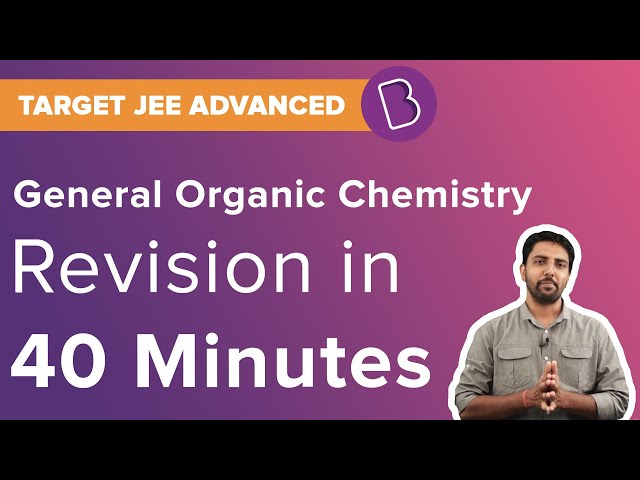General Organic Chemistry Previous Year Questions with Solutions can be accessed here. The different types of questions given here will help students to gain a better idea about the type of questions to expect from this chapter in the JEE Advanced exam. Meanwhile, General Organic Chemistry covers a large number of fundamental concepts in Chemistry. This chapter is also allocated the highest weightage of marks. Thus, going through the question and solutions will not only help them develop a strong understanding of the concepts but have a quick revision of the different topics. Ultimately, students will be able to study more productively for the entrance exam.
Additionally, students can also instantly download the General Organic Chemistry JEE Advanced Previous Year Questions with Solutions in a PDF format from this page.
Download General Organic Chemistry
Previous Year Solved Questions PDF
JEE Advanced Previous Year Questions on General Organic Chemistry
Question 1. Which of the following molecules in pure form is (are) unstable at room temperature?

Solution: (B and C)
In general, if we look at the Huckel rule, it states that compounds that have 4n (n = 0,1, 2, 3…) delocalised π-electrons in a close-loop are anti-aromatic and characteristically unstable. As such, in this case, compound B satisfies this criterion of anti-aromaticity. The molecule given in option C also follows Huckel’s criteria for anti-aromaticity and is therefore unstable.
Question 2. The number of resonance structures for N is.

Solution: (9)
In the given reaction, naphthalen-2-ol acts as an acid and reacts with NaOH to give salt sodium naphthalen-2-olate which is the compound N. The number of resonance structures for N is 9. They are as follows;

Question 3. The total number of lone pairs of electrons in melamine is.

Solution: (6)
If we closely observe the structure of melamine given above we can see that lone pairs are available only on the nitrogens. There are 6 nitrogen atoms in total therefore we will get 6 lone pairs.
Question 4. The total number of contributing structures showing hyperconjugation (involving C–H bonds) for the following carbocation is.

Solution: (6)
There are 6 H- atoms on the C- atom adjacent to the C- atom containing a positive charge.

Question 5. The carboxyl functional group (–COOH) is present in
A. Picric acid
B. Ascorbic
C. Barbituric acid
D. Aspirin
Solution: (D)
Aspirin, which is also known as acetylsalicylic acid and −COOH is present in it.

Question 6. Which among the following compounds is the most acidic.
A. p-nitrophenol
B. p-hydroxybenzoic acid
C. o-hydroxybenzoic acid
D. p-toluic acid
Solution: (C)
The main reason is due to the ortho effect. In o-hydroxybenzoic acid, hydrogen is attached to the oxygen of the hydroxide group. However, the hydroxide group is present at the ortho position. Ortho substituted benzoic acids are mostly acidic. So carboxylic acid is a bulky group and whenever any other species is present at ortho position then the plane distorts and equivalent resonance occurs which makes the molecule most acidic.
Ortho hydroxy acid is the strongest acid due to stabilisation conjugate by intermolecular H-bond which outweigh the electron-donating resonance effect of –OH.

Question 7. Amongst the following, the total number of compounds soluble in aqueous NaOH is:

A. 3
B. 5
C. 2
D. 4
Solution: (D)
The total number of compound soluble in aqueous NaOH is 4.
It will include compounds with either -COOH group or phenolic -OH group.

Question 8. The correct stability order of the following resonance structures is;

A. (I) > (II) > (IV) > (III)
B. (I) > (III) > (II) > (IV)
C. (II) > (I) > (III) > (IV)
D. (III) > (I) > (IV) > (II)
Solution: (B)
The stability of the canonical structures are decided by the following factors:
i) Neutral structures are most stable.
ii) Greater the number of covalent bonds, the greater is the stability
iii) Structure with a negative charge on the more electronegative atom will be more stable.
iv) Charge separation: like charges should be at the maximum distance.
Hence, the stability order is (I) > (III) > (II) > (IV)
Question 9. The correct acidity order of the following is;

A. III>IV>II>I
B. IV>III>I>II
C. III>II>I>IV
D. II>III>IV>I
Solution: (A)
Decreasing order of acidic strength is III>IV>II>I
Carboxylic acid is more acidic than phenol. When an electron releasing group is present in the para position to -COOH group in aromatic carboxylic acid, the acidity is reduced.
When Cl atom is present in the para position to -OH group in phenol, it increases its acidity. Here Cl atom withdraws electron density from the ring and stabilizes the phenoxide ion.

Question 10. The compound that does not liberate CO2, on treatment with aqueous sodium bicarbonate solution, is:
A. Benzoic acid
B. Benzenesulfonic acid
C. Salicylic acid
D. Carbolic acid (phenol)
Solution: (D)
NaHCO3 ⇌ Na+ + HCO-3
HCO-3 is decomposed by acid releasing CO2
HCO-3 + H+⟶ H2O + CO2
If acid is stronger than HCO-3 then CO2 is released. Phenol is less acidic and thus does not liberate CO2 with NaHCO3.
Recommended Video
General Organic Chemistry Solved Questions

General Organic Chemistry Top 5 Questions

Comments